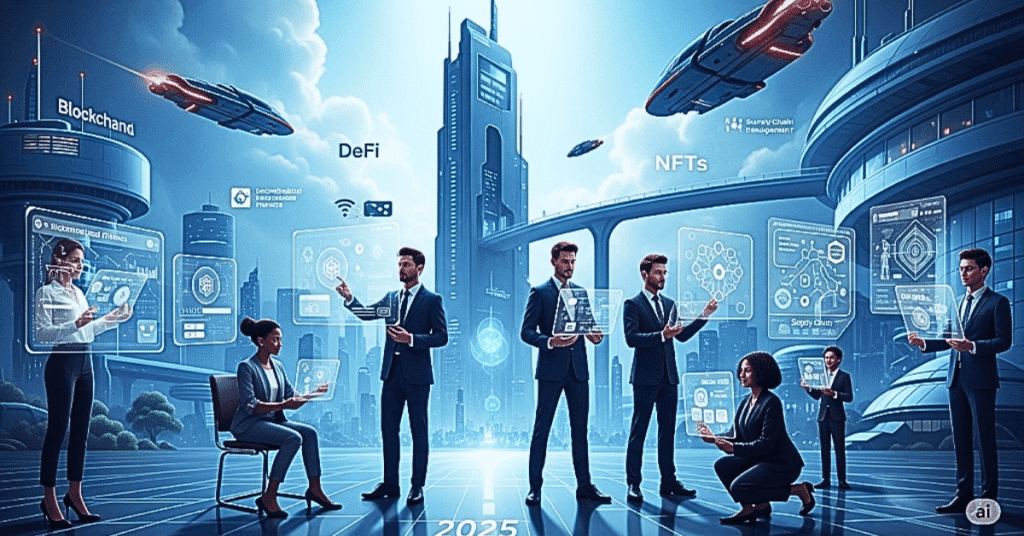1. Introduction to Blockchain Platforms
Essentially, blockchain technology is bringing about complete change in the paradigms of operations and processes into decentralized, secure, and transparent systems. The blockchain platforms are digital infrastructure used for building decentralized applications (dApps) along with smart contracts and digital assets .
These platforms were already maturing in 2025 beyond those earlier years. In fact, by 2025, perennial improvements with scalability, interoperability, and energy effectiveness were finding these platforms becoming robust engines of innovation in finance, supply chains, healthcare, gaming, and many others.
2. How Blockchain Works
These transactions are set in blocks and then linked up to the network of computers. Here are the essentials:
- Blocks: Collected data, including timestamp, transaction details, and hash.
- Hash: A cryptographic signature to ensure the immutability of the block.
- Nodes: Independent computers holding a copy of the ledger, validating transactions.
- Consensus Mechanism: Algorithms that would enable all nodes in the network to agree on the actual state of the blockchain. Such mechanisms include Proof of Work and Proof of Stake.
3. Core Features of Modern Blockchain Platforms
Modern features today are smart contracts, which, for example, take the form of self-executing contracts built on the blockchain and are enforceable without intermediaries in their operation.
a. Scalability
That is, their ability to keep on handling a higher number of transactions without sacrificing either speed or safety.
b. Interoperability
This addresses the ability to seamlessly integrate with various blockchains and traditional systems.
c. Decentralized Governance
These governance mechanisms allow communities or stakeholders to vote on a protocol upgrade or rules.
d. Tokenization
This helps to create digital tokens that represent a currency, stock, or other asset, as well as NFTs.
e. Privacy & Security
Cuts the Need for Shareable Runations-the most advanced cryptographic techniques, ZKPs and multi-party computation, lend privacy and transparency.
4. The Best Blockchain Platforms in 2025
Here are the most popular blockchain platforms that currently offer their services in the market, each of which is enhancing their offerings with varying features and ecosystems.
1. Ethereum 2.0
It transforms to Proof of Stake and sharded, but remains the best for building DeFi, NFTs, and dApps.
2. Solana
Combining speed with transaction and associated costs, it draws many high-velocity applications.
3. Polkadot
Dedicated to interoperability and cross-chain communications through parachains.
4. Avalanche
Specifies low-latency consensus on an application-specific blockchain dedicated to subnets.
5. Cardano
Heavily research-focused, Cardano pays special attention to formal verification in its production processes and energy conservation during its runs.
6. Polygon
Layer 2 solution for the reduction of gas costs while increasing the level of scaling of Ethereum’s operations.
5. Advantages of using a Blockchain platform
Blockchain platform is of advantage to industries, developers, and end-users as outlined below:
a. Trustless environment
Transactions do not need middlemen since they are verified by decentralized networks.
b. Transparency
This openness, evidenced by public records of all transactions, breeds trust and accountability.
c. Enhanced Security
A record is immutable, and cryptographic protections give rise to low rates of fraud and data breaches.
d. Cost Effective
Cost incurred reduces because of automation in systems.
e. Worldwide Reach
It runs 24/7 and is accessible from any corner of the world, which fits perfectly for trade and finance around the world.
6. Use Cases of Blockchain: Where They Are Applied
Blockchain applications are considered across different sectors. Let’s look at a few examples in real life:
a. Finance (DeFi)
Decentralized finance – no banks: lending, borrowing, and trading on platforms that use smart contracts.
b. Supply Chain Management
End-to-end product traceability that reduces fraud and improves transparency.
c. Healthcare
Secure sharing of medical records when permitted by patients, but maintaining integrity.
d. Gaming
Play-to-earn (P2E) models, NFT assets, and decentralized economies of play.
e. Real Estate
Enables dividing property assets by ownership share and simplifies their exchange.
f. Identity Verification
Self-sovereign identities give users the power to access personal data.
g. Voting Systems
Blockchain will give passage to implementing an almost tamper-proof and transparent digital voting process.
7. Some Factors to Look into When Choosing a Blockchain Platform
Before selecting a blockchain platform for development or investment, the following should be kept in mind:
a. Consensus Mechanism
Select PoW, PoS, DPoS, or newer algorithms depending on the requirement of speed and security.
b. Ecosystem Size
The larger the ecosystem, the better the community support, the number of dApps, and the more developer tools available.
c. Scalability
Look at the transaction speed and network throughput (TPS). d.
Transaction Costs
Some higher gas rates for using specific platforms might affect usability.
e. Compliance
Regulatory compliance: Support KYC/AML processes if required.
f. Smart Contract Language
Some use Solidity, while others use Rust, Move, or Vyper.
g. Interoperability
A platform with support bridges and cross-chain protocols.
8. Future of Blockchain Platforms
The future appears bright for blockchain platforms in 2025, riding on some of the top trends:
a. Modular Blockchains
Examples include Cosmos and Celestia, which are at the forefront of modular architecture, the consensus, execution, and data availability components of which are to be decomposed.
b. Zero-Knowledge Technology
ZK-rollups and zkEVMs will allow the development of scalable and privacy-enabling transaction types.
c. Business Adoption
Any company with a big name, including IBM, Oracle, and Microsoft, is passionate about integrating blockchain with business applications.
d. Ecological Blockchain
Emerging from the concern for the environment is the trend toward energy-efficient consensus models.
9. Challenges and Risks
Blockchain innovations bring several challenges to their effectiveness:
a. Scalability
The situation is improving, but still, most blockchains fail for large-scale adoption.
b. Regulatory Ambiguity
Adoption is thwarted due to the differences present in nations.
c. Security Weakness
Smart contract bugs and exploits within protocols are still common.
d. User-friendliness
The very complex interfaces and wall setups give an unpopular impression with the general public.
e. Interoperability
Progress is being made, but cross-chain real compatibility is still a work in progress.
f. Forks and Governance Disputes
Community disagreements can lead to contentious hard forks.
Conclusion:
Blockchain is now on the verge of creating a very digital future by placing society in a decentralized, secure, and transparent medium. Knowledge of the blockchain platforms would become very important in 2025 as a venture capitalist, entrepreneur, or developer.
You’d have to consider quite a few factors in assessing the best blockchain technology for you: scalability, for example, security, community support, and finally, overall ecosystem maturity.



